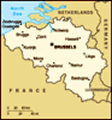Advertisement
Published: April 21st 2019
I've fallen well behind. The day before yesterday we were in Antwerp, famous for, among other things, being the birthplace of Peter Paul Rubens, one of the great artists of Holland's Golden Age (16th-17th centuries). The formal tour that morning included a visit to the cathedral, to Rubens’ house and collection, and some other historical sites. We decided to forgo the formal tour and explore on our own. Every place, every museum, was within walking distance, except for one, a private gallery of a collector named Axel Vervoodt. Vervoodt is an international art dealer, a collector of antiques and contemporary art, an interior designer, and real estate developer who’s latest project is the development of a cultural and residential complex at the site of an old distillery just outside of town. We planned to save that visit for later.
Using Google Maps as our guide, we walked through spotless, narrow streets with few cars. Unlike in Amsterdam, the bicyclists are not blind to pedestrians. It felt safer to walk. Buildings were a mix of old and new and they were of modest scale, three of four stories at most. Some of the buildings were from the 18th century and others
brand new and almost all were very well maintained. The ground floors often had stores, not chain stores, independently owned stores, selling clothing and jewelry. There were small restaurants, cafes, and coffee shops on both the small streets and in the numerous small squares. There were chocolate stores and spectacular looking bakeries. Apartments are above the retail. If this sounds like a place I’d like to be, it is. We walked slowly, navigating our way around town until we arrived at Rubens’ house, which is now a museum. It’s a nice house but the real reason to visit is to slowly look through all of the rooms and look at Rubens’ own collection of art other objects. Rubens was not only considered the leading Flemish painter of the early Renaissance, he also ran a large and studio that produced both commissioned and non-commissioned works. His Baroque style was very popular, and he was quite prolific at producing paintings and drawings that sold well to noblemen. Plus, he married well, which I'll get into more detail later. With his newfound wealth he was able to collect all sorts of objects; paintings and drawings from other leading Flemish and Italian artists, ornate
Flemish curio cabinets, antique and contemporary sculpture and furniture. The whole picture; the house, garden and collections tells a story of what life might have been life in the early 17
th century for one of Antwerp’s greatest talents and celebrities.
At Rubens’ house, we saw a portrait of his second wife, Helena Fourment. Rubens married her after his first wife died. He was 53 and she, 16. She was a considered great beauty we are told. The daughter of a successful silk and carpet merchant, her father owned several paintings by Rubens. Her portrait reminded me of another painting that we saw earlier in the week by Rembrandt, a painting of his second wife, Saskia. And over the last few days we saw many other paintings, including those by Franz Halls Jean Steen, Vermeer and even some lesser-known artists where the women looked a lot like Helena Fourment and Saskia. They all had several highly noticeable features, features considered then, to be attributes of beauty. They all had high foreheads, frizzy hair, a moderate plumpness (so that they can withstand a bout of influenza), and, of course, a large bosom. Today's tastes are different, except for the bosums.
Here are some pictures.
Later, with lunch, we decided that it would be terrible to go through Belgium and not drink some of their beer. Sitting at a café near the cathedral, I ordered a local, highly regarded (so said the waiter) lager , one of several hundred made in Belgium. Fran ordered a Kriek. It was recommended by the lady drinking it next to us – apparently very popular in Belgium. Kriek is a fruit beer, a mix of beer and cherry juice. That explains the red color. That explanation only came later. I wish I had a picture of Fran’s face when she tried it. Her expression was one of surprise and, while maybe not disgust, something close. Her eyes got big, her nose scrunched up, and her lips smacked together as if to protect her from having to taste more. My lager was spectacular. Sitting outside with a plate of wursts, some sauerkraut and a beer on a warm, sunny day was quite a treat. I only had half a beer though. Fran had the other half. The Kreik was left standing. I don’t drink enough good beer.
After lunch and a quick, a very quick visit to the cathedral, we went shopping. Nothing further to disclose except that it’s a nice town for that. We ran out of time for Axel Vervoodt. Next trip.
Advertisement
Tot: 0.091s; Tpl: 0.01s; cc: 9; qc: 40; dbt: 0.0538s; 1; m:domysql w:travelblog (10.17.0.13); sld: 1;
; mem: 1.1mb







